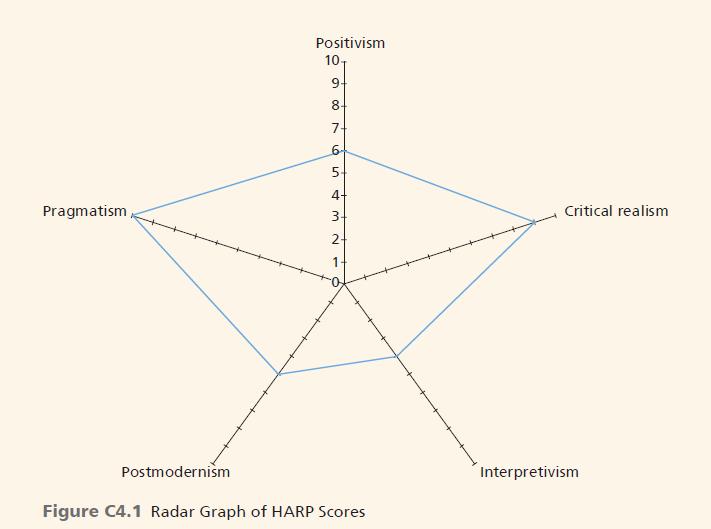After working for a decade in industry, returning to university to study for a Masters degree was
Question:
After working for a decade in industry, returning to university to study for a Masters degree was not as easy as Janet had anticipated. Whilst she was being awarded good marks on the assignments for a number of her taught Modules, she found the research methods module quite challenging. Furthermore, she felt daunted at the prospect of completing the module assignment, which required her, as part of her research proposal, to outline and justify her research philosophy. To begin with, Janet reread the research philosophy chapter in her module textbook. At the beginning of the module, she had found the descriptions of such terms as ontology, epistemology, axiology and methodology, confusing and difficult to understand. Now, after rereading the chapter, attending a seminar with her lecturer and discussing the concepts with other students in the coffee bar, she felt she was slowly making sense of such terms in her own mind.
However, despite this, Janet was still not clear as to how she might write about her research philosophy. The more Janet read around the subject and reflected on both the characteristics of different research philosophies discussed within the textbooks and her own values and beliefs, the more confused and frustrated she became. It seemed to Janet that each of the research philosophies outlined in the research methods textbooks had aspects that matched her values and how she viewed research and yet also had aspects with which she disagreed.
The possibility of outlining and justifying her research philosophy seemed to be receding rather than becoming more obvious. About this time Janet was encouraged by her lecturer to complete the HARP (Heightening Awareness of Research Philosophy) quiz to help her reflect on her research assumptions and research philosophy (you can find a copy in the section ‘Progressing your research project’ towards the end of Chapter 4).
Whilst she was at first sceptical, Janet was intrigued and completed the quiz, which asked her to think about her assumptions and beliefs. Working out her scores, she found that she scored 10 for pragmatism, 9 for critical realism, 6 for positivism, 5 for postmodernism and 4 for interpretivism. She plotted these on a radar graph (Figure C4.1).
Janet was surprised at the results. For example, she had expected a higher score for positivism and was similarly amazed that her score for postmodernism and interpretivism were higher than zero. She was further surprised and to an extent confused that she did not have a clear philosophical preference, having high scores for both pragmatism and critical realism. This puzzled Janet. Having gained some awareness of the concept of research philosophies building on particular assumptions and beliefs, she questioned the possibility of holding more than one philosophical position at the same time. She decided to ask her lecturer whether it might be considered possible to have multiple philosophical research positions.
Data from in Figure C4.1

As she contemplated these complex and challenging issues, Janet felt that she was becoming increasingly aware of the impact of her own research philosophy on her research design. Moreover, Janet felt that she was beginning to understand that not only should her research design and data collection and analysis methods be consistent with her research philosophy, but also that the method or methods used by researchers are indicative of their research philosophy. Janet was enthused and encouraged as she now recognized why her lecturer had emphasised the need to identify her own research philosophy.
Janet realised that she still had a lot of work to do to ensure the research design for her project was consistent with her research philosophy. However, she now felt more confident of her ability to undertake this task and that she had taken a major step forward in her long research journey. Having been prompted to reflect on her own values, beliefs and assumptions – and the HARP quiz, Janet felt that she had begun to gain some awareness of how a researcher’s perspective influences their choice of research topic and research question, their approach to theory development, methodological choice, data collection and analysis methods, as well as research outcomes (Alvesson and Sköldberg, 2009; Mir et al., 2016). Moreover, Janet’s increasing awareness of her own values and research philosophy, and her ability to be reflexive, meant she felt more empowered to assess other researchers’ work and their claimed contributions to knowledge (Cunliffe, 2003; Mir et al. 2016).
Later, over coffee, Janet had a thought-provoking discussion about research philosophies with her friend Brad, a doctoral research student. This, she felt, contributed significantly toward her developing capacity for reflexivity. After some debate about how certain research methods tended to be associated with particular research philosophies (Westwood and Clegg, 2003; Alvesson and Sköldberg, 2009; Mir et al., 2016), she began to wonder whether the way in which HARP had been framed, designed and intended to be used represented a particular philosophical perspective. Enthused and intrigued, Janet decided to undertake further reading and discuss her ideas with Brad. She recognised that although she had only just begun to understand her own assumptions and research philosophy, she could now complete her research proposal.
Questions
1 If you have not done so already, complete HARP for yourself. Use the questions at the end of the Chapter 4’s ‘Progressing your research project’ to reflect on your research philosophy. Discuss your answers with a colleague.
2 Why was it important for Janet to identify her research assumptions? Why is it important for you to reflect on your own assumptions?
3 Imagine you are Janet’s tutor and answer her question, ‘Is it possible to have more than one philosophical position?’
Step by Step Answer:

Research Methods For Business Students
ISBN: 9781292208787
8th Edition
Authors: Mark Saunders, Philip Lewis, Adrian Thornhill




